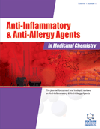- Home
- A-Z Publications
- Anti-Inflammatory & Anti-Allergy Agents in Medicinal Chemistry (Formerly Current Medicinal Chemistry - Anti-Inflammatory and Anti-Allergy Agents)
- Previous Issues
- Volume 14, Issue 3, 2015
Anti-Inflammatory & Anti-Allergy Agents in Medicinal Chemistry (Formerly Current Medicinal Chemistry - Anti-Inflammatory and Anti-Allergy Agents) - Volume 14, Issue 3, 2015
Volume 14, Issue 3, 2015
-
-
Novel 4- Aryl-2(1H)-phthalazinone Derivatives as Cyclooxygenase-2 Inhibitors: Synthesis, Molecular Modeling Study and Evaluation as Promising Anti-inflammatory Agents
More LessAuthors: Sherifa Hasabelnaby, Eman M. Mohi El-Deen and Ayman GoudahBackground: Inflammation is a natural reaction of our body in response to infection or any other injury to renovate that damage. The majority of the available Non-steroidal anti-inflammatory drugs is nonselective and consequently, causes gastric irritation and ulceration. Therefore, it is a beard to design and synthesize a new series of Non-steroidal anti-inflammatory drugs with minimal gastric complications. Methods: A se Read More
-
-
-
A Cross-Docking Study on Matrix Metalloproteinase Family
More LessAuthors: Mohammad Ramezani and Jamal ShamsaraBackground: Matrix metalloproteinases (MMPs) contribute to various physiological and pathophysiological processes. An imbalance in MMP activity causes pathological conditions including inflammatory diseases, cancer, and cardiovascular diseases. Each MMP member has many 3D structures available; therefore, selecting one structure for virtual screening becomes challenging. Methods: In this study, we used the cross-dockin Read More
-
-
-
Synthesis, Structure Activity Relationship (SAR), and Biological Activities of Benzylideneacetophenones Derivatives
More LessAuthors: Alka N. Choudhary, Arun Kumar and Vijay JuyalBackground: Oxygen has double-edge properties as it is essential for life, but can also provoke oxidative stress by protein & lipid per oxidation. The persistent oxidative stress and excess LPO induce several inflammatory mediators such as prostaglandins and leuckotrienes by activating enzymes cyclooxygenase and lipoxygenase. The per oxidation can be blocked by free radical scavengers as antiinflammatory agents. Most of the Read More
-
-
-
Synthesis, Anti-inflammatory Activities and Mechanisms of 3,5- dihydroxycinnamic Acid Derivatives
More LessAuthors: Meng-Jun Zhang, Juan Zhou, Wen Cao, Zhi-Qiang Feng, Jia-Wei Guo, Qing-Juan Han, Wen-Xuan Cao, Xiao Guan, Yun-Yun Li, Jianbo Qin, Yu Wang, Hui-Jing Zhang and Bin LiBackground: 3,4-dihydroxycinnamic acid and its derivatives exhibit numerous biologic activities. Such activities have not previously been reported for 3,5-dihydroxycinnamic acid derivatives. In this study, ten derivatives of 3,5- dihydroxycinnamic acid were synthesized and their anti-inflammatory activities were tested in 12-O-tetradecanoylphorbol 13-acetate-induced mouse ear edema. Molecular biological studies ha Read More
-
-
-
Do Rheumatoid Arthritis Patients Rate their Health Status Different than their Caregivers?
More LessAuthors: Sami Bahlas, Omar Fathaldin, Nahid Janoudi, Hani Almoallim, Ashraf Ibrahim and Shereen AlgoharyObjective: To compare the ratings given by the caregivers regarding the health status of their rheumatoid arthritis (RA) patients to those recorded by the patients themselves and to assess the effect of caring for a patient with RA on the mental health of the caregiver. Methods: This is a non-interventional, cross-sectional, multi-center epidemiological study conducted at the outpatient clinics of two hospitals in Saudi Arabia. Th Read More
-
-
-
Design, Synthesis and Biological Evaluation of New Thieno[2,3- d]pyrimidines as Anti-inflammatory Agents
More LessAuthors: Afaf A. El-Malah and Asmaa E. KassabBackground: Long term use of NSAIDS is mainly accompanied by major health implications such as gastrointestinal erosions, ulcerations and nephrotoxicity. These side effects arise from local irritation by the carboxylic acid moiety, that is common to most of NSAIDs (topical effect), in addition to decreased cytoprotective prostaglandin production. Therefore, in the medicinal chemistry research area, there is an ongoing Read More
-
Volumes & issues
-
Volume 24 (2025)
-
Volume 23 (2024)
-
Volume 22 (2023)
-
Volume 21 (2022)
-
Volume 20 (2021)
-
Volume 19 (2020)
-
Volume 18 (2019)
-
Volume 17 (2018)
-
Volume 16 (2017)
-
Volume 15 (2016)
-
Volume 14 (2015)
-
Volume 13 (2014)
-
Volume 12 (2013)
-
Volume 11 (2012)
-
Volume 10 (2011)
-
Volume 9 (2010)
-
Volume 8 (2009)
-
Volume 7 (2008)
-
Volume 6 (2007)
-
Volume 5 (2006)
Most Read This Month
Article
content/journals/aiaamc
Journal
10
5
false
en


